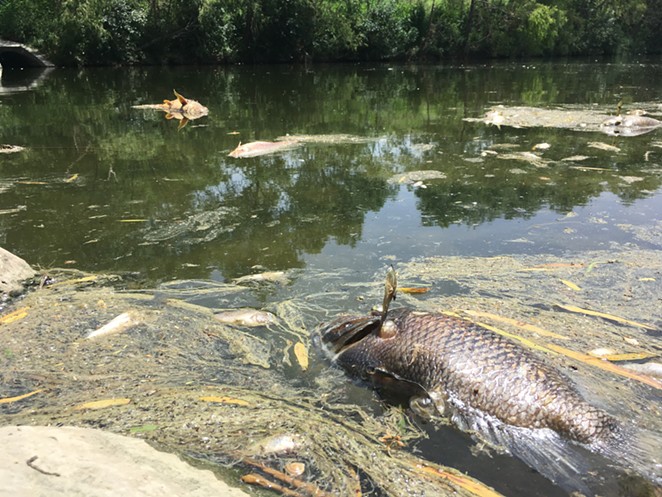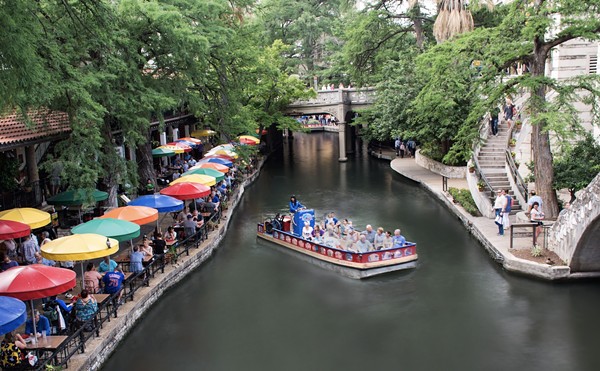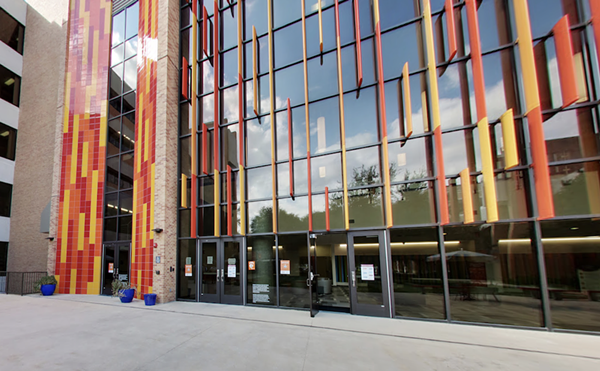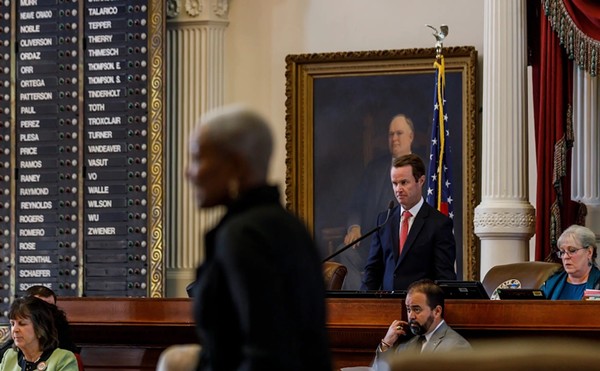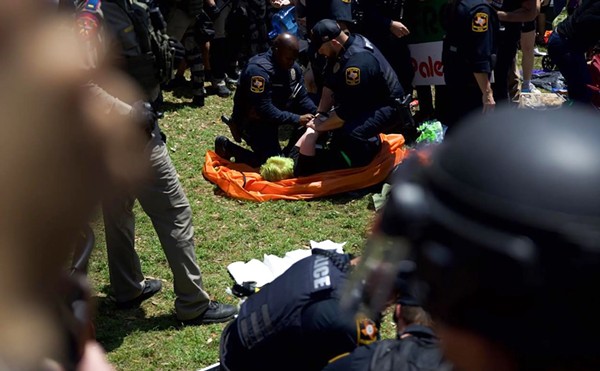Nearly 5,500 Fish Are Dead From San Pedro Creek Ammonia Spill, River Authority Reports
By Katie Hennessey on Thu, Jul 2, 2020 at 5:52 pm
An ammonia spill in the San Pedro Creek this week has killed nearly 5,500 fish, according to a tally conducted by the San Antonio River Authority on Thursday.
Ammonia entered the creek through a storm drain on South San Marcos Street after a leak in the refrigeration system at the nearby Kiolbassa Smoked Meat plant on Monday night.
"The number of dead fish was surprising," Christopher Vaughn, SARA aquatic biologist, told the Current. "We got down there expecting 50 to 100 fish, and now we're at 5,500 fish later."
SARA biologists, along with Watershed Parks and Operations, began gathering data early Wednesday morning. Researchers started at San Pedro Creek and Furnish Avenue, where the ammonia entered the creek, then worked their way South on the Mission Reach section of the San Antonio River.
"Our goal today was to get the hot spots," Vaughn said. "We wanted to get to the point where fish were very sparse, because there is no way we can get to every single fish."
SARA received calls about the ammonia leak on Tuesday, initially estimating that around 50 fish had died. Vaughn said the true story came after getting into the water and investigating, revealing a larger impact than expected.
The River Authority measured fish by the barrel. The latest official count Thursday was an estimated 5,300, though Vaughn said the number is likely closer to 5,500.
The team also collected subsamples over the past two days, gathering information on size, species and distribution of the perished fish. A report was sent to the Texas Parks and Wildlife Department (TPWD), which will be used to tabulate restitution payments to cover the damage.
"There is a restitution value for lost fish due to pollution events," said Travis Tidwell, an aquatic biologist with TPWD Kills and Spills Team. "We will take a look at the damage and the potential responsible party, then develop a monetary value of the lost resource."
TPWD will determine restitution based on loss of fish and wildlife as well as cost associated with investigations. Compensation — either monetary or through settlement projects — will be used to help restore the habitat and improve fish population.
Species Impacted
Among the fish collected out of the creek and Mission Reach of the San Antonio River, were non-native species including carp and tilapia. Tidwell said a few game species including Largemouth bass, Guadalupe bass and channel catfish were also among the number.
That information will ultimately help inform the value of ecological impact caused by the ammonia spill, he added.
Out of the near 5,500 fish killed, Vaughn said the SARA team found 13 species, including both native and non-native fish. Crawfish were the only other wildlife either scientist found dead from the toxicity.
While collecting fish, Vaughn did find something to be happy about.
"We did find a really cool species of fish, a new resident to the Mission Reach, hopefully," he said.
The Grey Red Horse is an intolerant species, one that Vaughn said SARA biologists were hoping to reintroduce into the Mission Reach in the future. Though they only found one, Vaughn said he was pleasantly surprised to find it naturally occurring.
"It's just unfortunate that in order for us to find it, it was when it was perished," he added
'Nature Will Take Over From Here'
For the River Authority, the field work is mostly done. Over the past two days, the crew has gathered dead fish and collected data from the major hot spots on the San Pedro Creek and San Antonio River.
"Nature is going to take over from here," Vaughn said.
Fortunately, the ammonia toxicity will decrease almost immediately, he added. SARA took river samples Wednesday, and while they wait on results, Vaughn said he was confident in San Antonio's water system's resilience.
"Obviously, we don't want this to happen anywhere on a river — but we are fortunate in the place it occurred, knowing that everything up from the confluence is fresh water, constantly flowing, bringing new fish, turtles and new wildlife in," he aded. "Those fish will repopulate this area again. We will bounce back again."
Stay on top of San Antonio news and views. Sign up for our Weekly Headlines Newsletter.
Ammonia entered the creek through a storm drain on South San Marcos Street after a leak in the refrigeration system at the nearby Kiolbassa Smoked Meat plant on Monday night.
"The number of dead fish was surprising," Christopher Vaughn, SARA aquatic biologist, told the Current. "We got down there expecting 50 to 100 fish, and now we're at 5,500 fish later."
SARA biologists, along with Watershed Parks and Operations, began gathering data early Wednesday morning. Researchers started at San Pedro Creek and Furnish Avenue, where the ammonia entered the creek, then worked their way South on the Mission Reach section of the San Antonio River.
"Our goal today was to get the hot spots," Vaughn said. "We wanted to get to the point where fish were very sparse, because there is no way we can get to every single fish."
SARA received calls about the ammonia leak on Tuesday, initially estimating that around 50 fish had died. Vaughn said the true story came after getting into the water and investigating, revealing a larger impact than expected.
The River Authority measured fish by the barrel. The latest official count Thursday was an estimated 5,300, though Vaughn said the number is likely closer to 5,500.
The team also collected subsamples over the past two days, gathering information on size, species and distribution of the perished fish. A report was sent to the Texas Parks and Wildlife Department (TPWD), which will be used to tabulate restitution payments to cover the damage.
"There is a restitution value for lost fish due to pollution events," said Travis Tidwell, an aquatic biologist with TPWD Kills and Spills Team. "We will take a look at the damage and the potential responsible party, then develop a monetary value of the lost resource."
TPWD will determine restitution based on loss of fish and wildlife as well as cost associated with investigations. Compensation — either monetary or through settlement projects — will be used to help restore the habitat and improve fish population.
Species Impacted
Among the fish collected out of the creek and Mission Reach of the San Antonio River, were non-native species including carp and tilapia. Tidwell said a few game species including Largemouth bass, Guadalupe bass and channel catfish were also among the number.
That information will ultimately help inform the value of ecological impact caused by the ammonia spill, he added.
Out of the near 5,500 fish killed, Vaughn said the SARA team found 13 species, including both native and non-native fish. Crawfish were the only other wildlife either scientist found dead from the toxicity.
While collecting fish, Vaughn did find something to be happy about.
"We did find a really cool species of fish, a new resident to the Mission Reach, hopefully," he said.
The Grey Red Horse is an intolerant species, one that Vaughn said SARA biologists were hoping to reintroduce into the Mission Reach in the future. Though they only found one, Vaughn said he was pleasantly surprised to find it naturally occurring.
"It's just unfortunate that in order for us to find it, it was when it was perished," he added
'Nature Will Take Over From Here'
For the River Authority, the field work is mostly done. Over the past two days, the crew has gathered dead fish and collected data from the major hot spots on the San Pedro Creek and San Antonio River.
"Nature is going to take over from here," Vaughn said.
Fortunately, the ammonia toxicity will decrease almost immediately, he added. SARA took river samples Wednesday, and while they wait on results, Vaughn said he was confident in San Antonio's water system's resilience.
"Obviously, we don't want this to happen anywhere on a river — but we are fortunate in the place it occurred, knowing that everything up from the confluence is fresh water, constantly flowing, bringing new fish, turtles and new wildlife in," he aded. "Those fish will repopulate this area again. We will bounce back again."
Stay on top of San Antonio news and views. Sign up for our Weekly Headlines Newsletter.

KEEP SA CURRENT!
Since 1986, the SA Current has served as the free, independent voice of San Antonio, and we want to keep it that way.
Becoming an SA Current Supporter for as little as $5 a month allows us to continue offering readers access to our coverage of local news, food, nightlife, events, and culture with no paywalls.
Scroll to read more San Antonio News articles
Newsletters
Join SA Current Newsletters
Subscribe now to get the latest news delivered right to your inbox.

